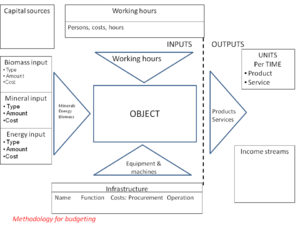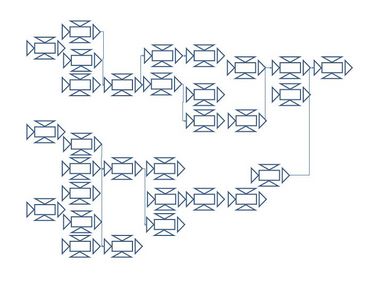Financial Permaculture Worksheet
Introduction
This is a method for using the cafe commons with financial permaculture. It can be used to plan a start up sustainable community or to develop a more resilient local business.
It has one major element: The object worksheet
Setting the Stage for Using the Worksheet
For the first use, start by asking participants in an open space setting to identify which objects they think would be included in their commons initiative or community initiative. Each object then gets one large paper with the worksheet printed on it, and participants group up to work on the object of their choice.
There is an art to this: identifying objects at too small a scale gives you a lot of separate items to deal with. If you choose too large a scale the exercise will get too complicated. For the sake of overview a commons initiative should have a maximum 12 objects and these in turn can be broken down further.
One team or working group should be responsible for the object. If you choose objects that have cross responsibilities it complicates matters. There is no perfect answer to this and it is always worth trying out different ways of breaking infrastructure down into objects until you feel you have clarity of responsibility and function.
(examples of objects: Kitchen, serving area, housing, boiler rooms, community farms, ponds, greenhouses, shops)
Estimation of Inputs and Outputs for the object
For each object, they need to identify its function and output. Then they need to estimate inputs and outputs as well as costs. One way to do this is to ask yourself
- What is the lowest it could be?
- What is the highest it could be?
- Now that we have an estimation range, is our actual most likely to be in the lower, middle or higher end of my range?
Provides the answer to where to estimate costs. This of course works better as group discussion.
Income and Capital Sources
They then need to think about where income and capital can come from, how to reward output and where to find capital.
Before all of this is given over to a group to collate to create a summary budget, groups need to put together each sheet so input and output match. One "waste" might be another's input!
Address the Whole System
Finally, with all the sheets up and connected (they might look like something in the illustration above,) you need to regroup to go through the permaculture questions for the whole system:
- Can you use more renewable energy in the steps?
- What waste is produced. Can one object’s waste be another’s raw materials?
- Where nature can do the job, can we let it?
- Can we make solutions smaller and slower?
- Can we produce a wider variety of solutions/products for resilience
- How can we ensure the network of objects survives scenarios we expect like financial stress, higher energy prices, impact of new technology?
Differences between this and traditional financial approaches
There are some subtle differences just as the permaculture way of producing vegetables and plain old gardening have commonalities and differences.
- One of the aims of FP is to retain money as long as possible in the local community (See all written on "slow money")
- The aim of financial permaculture is to obtain a yeild of "money's worth" rather than money itself
- The idea of interest does not fit FP in fact, one of the aims of finacial permaculture is to find alternative sources of capital to bank loans.
- FP seeks to get nature to do as much of the work as possible. Traditional financial approaches do not encompass this, in fact they try to get fossil fuels to do as much of the work as possible.
- FP puts a value on waste and pollution. Traditional finance sees the cost of getting rid of them. That gasoline was early on conceived as a fuel in automobiles was something Rockefeller was interested in as gasoline was a messy by-product of his cooking and lighting oil business.
- FP is more about asset based investment, valuing labour and nature whereas most traditional accounting models treat these as commodities
- FP looks at an ecology of functions. This would be more like looking at how a supply chain worked rather than focussing on a specific business.
- Financial permaculture (permanent culture) seeks to create infrastructure that will produce a standard of living over time with minimum impact on nature. Again similar to business modelling but within another context.
Note from the Author
Feedback is appreciated. Please leave a note here on the discussion page. It is certain that instructions could be clearer or more robust. What else is being left out?

